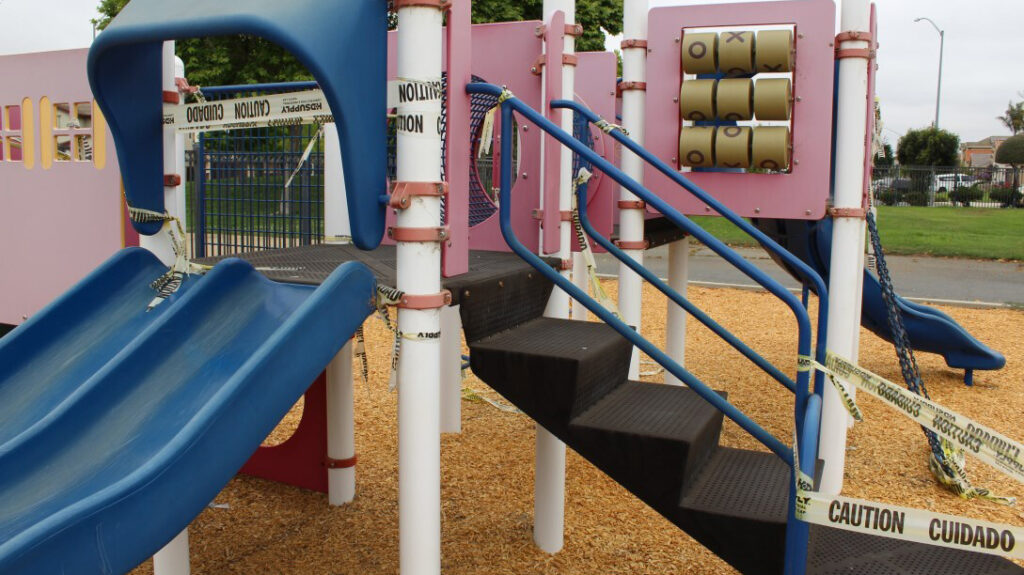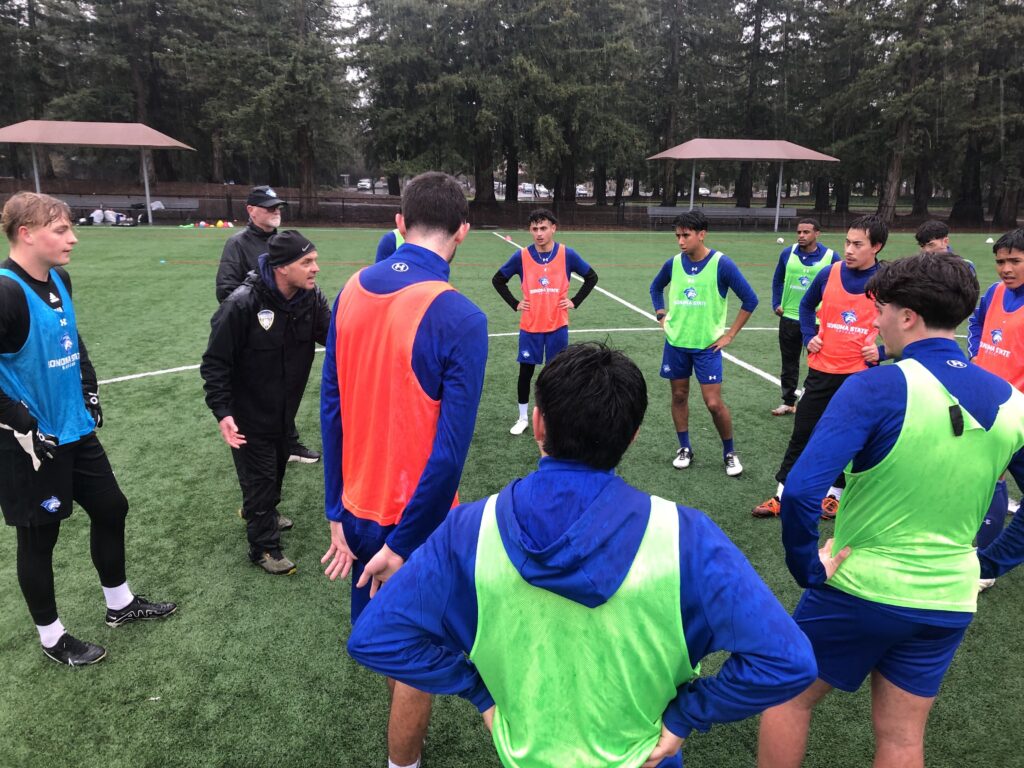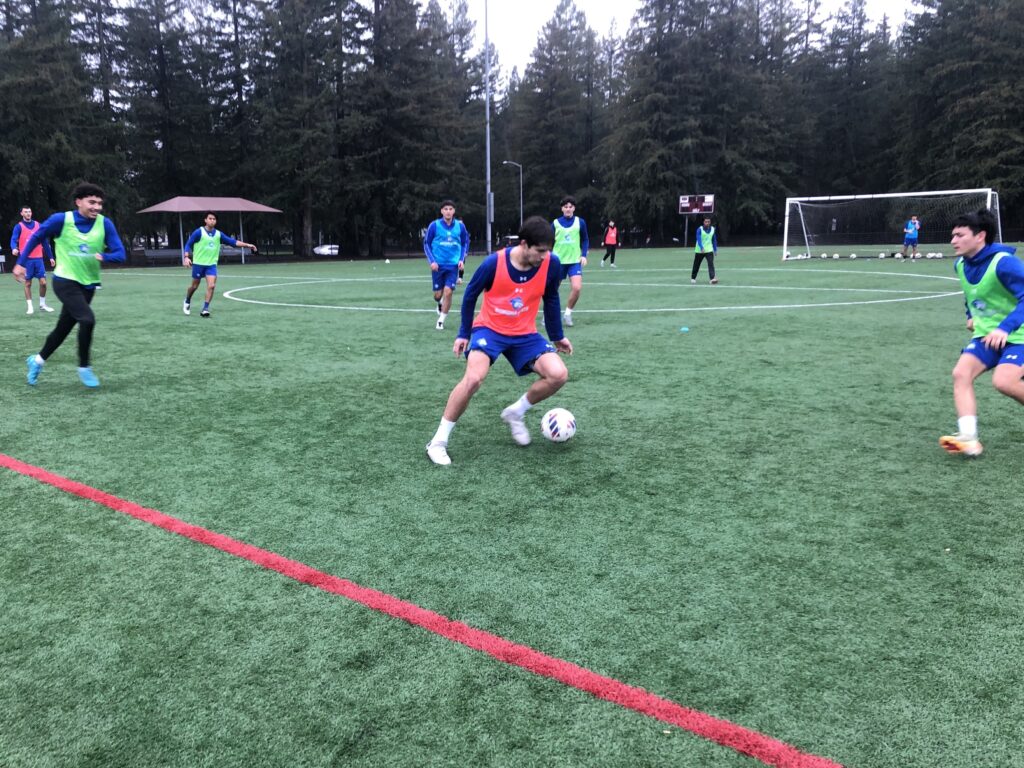
An off-limits, aged and rusting play structure, Santa Rita Union School District
Credit: Santa Rita Union School District
In the coming days, Gov. Gavin Newsom is expected to confirm his commitment to place a state school construction bond on the November ballot.
What he hasn’t committed to yet — but must decide in the next 10 days — is whether to reform a method of sharing state matching money that has long favored property-rich districts over their property-poor neighbors.
Along with a June 27 deadline to write ballot language, Newsom and legislative leaders face the threat of a lawsuit challenging the legality of the present system that ignores vast inequalities in districts’ ability to upgrade and repair schools. The public interest law firm Public Advocates filed its warning, a 21-page demand letter, with state officials in February. Public Advocates is calling for a new method that shares more state bond proceeds with districts that need more help. Their proposal focuses only on repairing and renovating facilities, not new construction.
The possibility of litigation drawing attention to funding inequalities would endanger the chances that a bond would pass — just when the state will run out of distributing the last matching money from the last bond, eight years ago. That would leave the state with no funding to help districts meet the rising cost of school construction.
Newsom’s aides and legislative leaders have expressed interest in proposals for a fairer system of allocating state funding, “but it is far from clear where the equity conversation will land,” said John Affeldt, managing attorney for Public Advocates.
“As long as state bond funding continues to exacerbate rather than redress local wealth disparities, the constitutional problem and our legal demands remain.”
Past California State School Board President Michael Kirst agreed. “We need to complete the job of making California school finance more equitable. This is a long-overlooked and needed area for political action.”
Late last month, Assemblymember Al Muratsuchi, D-Torrance, who chairs the Assembly Education Committee and authored a bill establishing a construction bond, predicted that the measure would be between $10 billion and $12 billion for TK-12 and community colleges. Whether it would include construction money for four-year universities hasn’t been announced.
The Coalition for Adequate School Housing or CASH, the influential lobby representing school districts and school construction contractors, opposes including the University of California and California State University. It argues schools and community colleges need the full $14 billion in Muratsuchi’s bill — and more — to meet higher costs of construction, demands for climate-resilient schools, requirements for transitional kindergarten classrooms, and evolving needs for student wellness and after-school activities.
Talks between Newsom and legislative leaders must also settle how much should be designated for new construction relative to repairing and renovating existing buildings, and how much should be set aside for removing lead in water.
But the most contentious issue will be the distribution formula: determining how much money districts must raise in property taxes to qualify for a matching amount from a state bond. For the past 25 years, every district has ponied up the same percentage match on a first-come, first-served basis: a 50-50 split for new construction and 40% district and 60% match from the state for upgrading facilities.
The result has been predictable: Those districts with higher property values have gotten a disproportionately large piece of the pie.
‘The very definition of a regressive tax’
The Center for Cities + Schools at UC Berkeley examined the state funding distribution of the 813 school districts that received state modernization funding from 1998, when the current distribution method was created, through 2023. The analysis showed that the quintile of districts with the lowest assessed property value — those with a median of $798,000 per student — received $2,970 in modernization funding per student, while the districts in the highest quintile, where the median assessed property value was $2.3 million per student, received $7,910 per student — more than two-and-a-half times as much. As a result, districts with a lower assessed property value per student must impose higher property taxes on its residents than would a higher-wealth district to upgrade a school building.
“Imposing a greater tax burden on a community of lesser wealth is the very definition of a regressive tax,” said Jeff Vincent, co-director of the Center for Cities + Schools.
Compounding the problem of low property values in many districts is the state restriction that limits a district’s bonding limit to 1.25% of a district’s total assessed property value for elementary and high school districts and 2.5% of the total value for unified districts.
Combine those two factors, and you have the dilemma facing hundreds of districts including, the 3,200-student Santa Rita Union Elementary District and neighboring Salinas City Elementary School District, both in Monterey County.
“Our biggest difficulty is bonding capacity. We’ve basically bonded at our allowable capacity, and we did that to try to build up what we need for the state matching in particular,” said Santa Rita Superintendent Melissa Alderman.
With the latest bonds, Santa Rita nearly topped out at $27 million — far short of the more than $100 million the district needs to renovate, repair, and replace its four elementary and two middle schools at state standards.
The difference would provide what many districts take for granted: There would be appropriately sized gyms for middle school; the deteriorating track would be paved so that their schools could host meets; 40-year-old portable classrooms sitting on dirt would be replaced with more spacious modular classrooms on concrete foundations. There would also be transitional kindergarten classrooms the district can’t build and room for student and family service partnerships that the district has had to decline.
“All of our roofs would not be leaking; all of our gutters would be unrusted; tree roots wouldn’t be breaking up the sidewalks,” Alderman said. “Alarm systems not going off in the middle of the night because it rained too hard and something shorted.”
Santa Rita can generate only $7,740 per student in bond capacity; across the Salinas Valley, Carmel Unified can raise $190,000 per student. With English learners comprising nearly half of students and a high rate of poverty, Alderman worries about adding to families’ property tax burden — even if she could ask for another bond.
Santa Rita qualified for the state’s financial hardship assistance funding for the full cost of projects that exceeded funding capacity, but Alderman says the formula for determining the amount of hardship aid was insufficient.
“We’ve gotten just enough funding to always be making repairs and patching and hoping a big emergency doesn’t happen,” she said.
Salinas City Elementary School District, with 8,200 students whose families are similar to those in Santa Rita, is somewhat better off. It passed two bonds for $175 million two years ago, which has placed “an incredible burden” on the community but will cover about a third of its modernization needs, said Superintendent Rebeca Andrade. She worries whether, after chipping away at replacing roofs, ramps and windows, there will be enough left for a community priority: upgrading kitchens in every school so that children can eat fresh food like the vegetables grown and picked in nearby fields.
Public Advocates’ proposal
Salinas and Santa Rita would be among the districts that would get significantly more state funding under Public Advocates’ proposal.
Instead of a 60% match for all districts, money would be distributed based on assessed value per student. Under its latest proposal, the districts with the most property wealth — Beverly Hills, Carmel Valley, San Francisco Unified, and Sunnyvale School District Elementary in Silicon Valley — would be among those receiving a 5% state match for contributing 95% of the project’s cost.
The property-poorest—Bakersfield, Dinuba, Lindsay, San Bernardino City and Fresno Unified — would get a 95% match for contributing 5%. Salinas City Elementary would get an 81% match for contributing 19%, while Santa Rita would get 87% state funding for contributing a 13% local match, enabling the district to stretch its dollars and broaden its vision for creating a quality learning environment.
Affeldt said something like a 5%-95% scheme is needed to begin to offset local wealth disparities.
The Center for Cities + Schools has also calculated the impact of a 20%-80% match, which would be less progressive while flattening the gains and losses that districts would receive.
But there’s a caveat: The state match provides funding on a per-student basis, not on the size of a project, said Tom Pace, vice chair of CASH and the director of facilities of San Bernardino City Unified. “So we’re talking about a percentage of the grant amount, not a percentage of construction costs,” Pace said. “The majority of the costs associated with building schools are borne by local districts.”
Since the current system of matching funds started in 1998, school districts have raised nearly $3 for $1 contributed by the state — $125 billion to $43 billion, according to the Center for Cities + Schools.
A formula that sends a larger match to districts like San Bernardino would go a long way to solve inequitable funding, Pace said. But it will take an adequate level of state funding to address the full problem, he said. “San Marcos High School is one of the nicest high schools I’ve ever seen. I got confused with (CSU San Marcos) when I drove past,” he said. “There is no way that San Bernardino will ever have a high school that looks like that because of our low assessed value and growth.”
Big tax-base exceptions
There’s a correlation between residents’ income and assessed value per student. The quintile of districts with the highest assessed property per student generally consists of small, wealthy communities like Santa Monica, Beverly Hills, and, in Silicon Valley, Saratoga. The quintile of districts with the lowest property values per student are generally low-income communities.
But there are significant exceptions, including urban areas with big industrial and commercial tax bases. Oakland Unified, with 76% low-income families but $1.6 billion in bonding capacity, and Los Angeles Unified, with 81% low income families but $18.4 billion bonding capacity, would see their modernization match drop from 60% to 55%, under Public Advocates’ proposal. San Diego Unified, the state’s second-largest district, would see its state share drop from 60% to 51%.
CASH, which has underwritten previous campaigns to promote state school facilities bonds and on its own authored the last bond that voters passed, in 2015, also opposes Public Advocates’ proposal. Reforms that would prioritize school facility funding based on lower assessed valuation “appear to create winners and losers and disrupt the stability of the current School Facility Program,” CASH said in a May 23 letter to Newsom and legislative leaders. “CASH advises against hastily adopting significant changes to the (current program) without fully vetting their impact.”
CASH’s position is that improving access to the existing school facilities program is the way to address concerns. Tiny districts with under $15 million in assessed value would automatically get full assistance; its proposal also would reserve 20% of funding for districts that could qualify for up to 100% state aid. “Those typically end up being lower wealth districts that have struggled to provide local matches,” said CASH Chair Alan Reising, the business services administrator for Long Beach Unified.
Public Advocates argues a sliding-scale system would eliminate most of the need for the financial hardship program.
CASH would also permit supplemental funding for priorities like transitional kindergarten classrooms and climate resiliency measures. Public Advocates agrees with this concept and would include community schools’ additional space needs. It also supports setting aside 5% of state funding for technical guidance, since many districts lack the expertise to compete for what has been a first-come, first-served program.
But CASH would maintain at least the current 60% state match for all districts, with some districts entitled up to 70%, based on an index of high-needs students and bonding capacity. It’s a slight variation of Muratsuchi’s AB 247, the current proposal for the November bond. An analysis by Cities + Schools found that the nudge toward equitable funding would have little effect, other than to add costs.
“These are token changes that are really not going to move the needle in any meaningful way,” said Vincent, the co-director of the center.
Analogy with famous Serrano lawsuit
Public Advocates has filed a number of regulatory challenges and lawsuits over the past 25 years on education adequacy and funding, so it’s not surprising that it is focusing on facilities funding. What is surprising is that a similar threat hasn’t risen sooner.
Fifty-three years ago, setting a precedent for the nation, the California Supreme Court struck down relying on local property taxes to fund schools as violating the constitutional right of students in low-wealth districts to have access to an equal education. That led to a state system of equalizing K-12 funding and then, in 2013, to the Local Control Funding Formula. It directs extra resources to districts based on their numbers of English learners, low-income students, and foster children.
Public Advocates argues the current system of funding school facilities is comparable to the property-tax-based system of operating schools that the court rejected in the Serrano v. Priest decision.
Many states insufficiently fund school facilities, but California’s present system remains one of the most regressive because it ignores vast differences in property wealth, Vincent said. Public Advocates based its model on Kansas’ sliding scale.
It’s an open question whether Newsom, legislative leaders, and ultimately voters would agree to a formula with new “winners” and “losers” to achieve a more equitable distribution of state funding.
As an administrator of a district that would gain the most from Public Advocates’ plan and as one of 11 members of CASH’s board of directors, Pace said, “I like the sliding scale; I would just advocate that there be a base amount that you start with.”
Otherwise, he foresees the breaking apart of a unified front for a state bond, and it is critical for today’s children to pass a bond this year, Pace said. “To pass a bond, you have to have a coalition, and coalitions generally don’t vote for things that are equitable, because you’re going to have people that say, ‘Well, if I contribute (to the campaign), what do I get out of it?’”
Kirst, who co-authored the Local Control Funding Formula, nonetheless encourages state leaders to press forward. “The issue has flown under the radar for so many years,” he said. “School construction has been controlled by groups that sponsor the initiative, but that does not excuse the lack of attention.”













